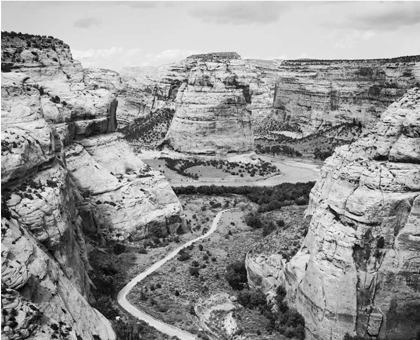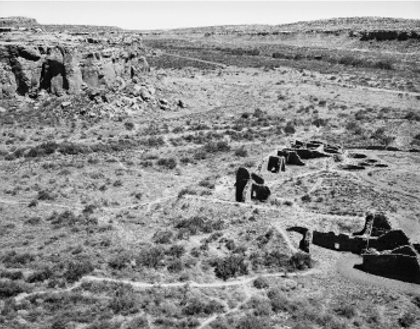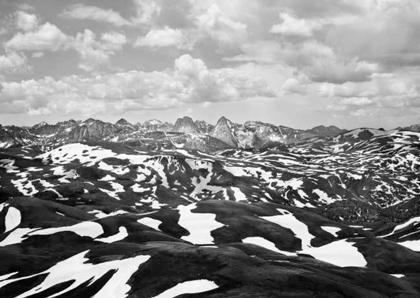
| |
 |
This finely-produced book showcases the black-and-white landscape photographs of contemporary photographer William S. Sutton. Most of the book is comprised of images offset by plenty of white space, but there are two essays on the artist's work by Toby Jurovics and Susan B. Moldenhauer. Sutton specializes in photographing landscapes in the American West. The book focuses on high mountain, short-grass prairie, and desert environments in the Four Corners states, vast stretches of difficult country empty of human presence. A few photographs in the Southwest show pictographs or ruins. All of the photos were taken on public lands; they document BLM and National Forest Service areas, which are simultaneously the most wild and the least protected of all public lands. Save for the very rare appearance of a truck in the distance, these images could have been taken a century ago. Sutton thinks like a field geologist, with a serious disinterest in anything covering up the good rocks. His photos show asphalt roads past towers of bare rock, thin desert cover worn to dust by the patterns of animal trails. He works at specific locations and seasons to avoid attention to flowers, soft herbs, insects, or animals. (In one or two pictures, distant bison appear as black spots on the geology.) The total effect is remarkable, an anti-romanticism as lushly romantic as a Clint Eastwood film. —Eithne O'Leyne, Editor, ProtoView, Ringgold, Inc. |
| "Dramatic monochromes of public lands in the American West are almost automatically associated with artists like Timothy O'Sullivan or Ansel Adams. But there are equally talented contemporary photographers, and William Sutton is one of them. His evocative images of Western public lands range from close-ups of frothing mountain streams to vast, sweeping landscapes that seemingly cover as much territory as do small Eastern states. The wonderfully wrought plates in Sutton's book—imagery from 46 public lands in 13 Western states—are accompanied by a text that is as lively as it is thoughtful. The critical essays by Toby Jurovics and Susan Moldenhauer, both curators of major art museums, lend an interpretive depth to Sutton's text and images. This is a book that is not just the first of its kind. It is one in which we can immerse ourselves for hours, letting our imaginations run as free as a desert wind or a mountain breeze." —John Logan Allen, Emeritus Professor of Geography, University of Wyoming, Honorary Life Member of the Western History Association, and Fellow of the Society for the History of Discoveries "Here's a test: open this book and look at Willy Sutton's superb pictures and then try not to fall even more deeply in love with our magnificent western continent. I bet you can't. I couldn't. It made me want to grab some gear, hit the road, and see more of this magnificence first-hand." |
 |
 |
"Sutton surveys the vast public lands of the West as they are, showing mountain peaks, saguaro forests, pictographs, and sand dunes, as well as roads, bison, people, fences, mining, and foresting. The signs of habitation and development neither mar nor overwhelm Sutton's West but rather lend a reassuring authenticity to his depiction of the place he calls home." —Rebecca Senf, Norton Family Curator of Photography, Center for Creative Photography and Phoenix Art Museum, and author of Reconstructing the View: The Grand Canyon Photographs of Mark Klett and Byron Wolfe "Sutton's resonant photographs evoke the deep silence and seemingly endless spaces of the American West as it must have been 200—or 2,000—years ago. That sense of continuity offers reassurance in an era of constant, sometimes drastic, environmental change and gives us something to stand on as we shape the future of the places that belong to every one of us. At Home in the West is an important artistic contribution to the ongoing conversation about our environmental attitudes, perceptions, and values." |
"It is all too easy, when looking at photographs of Western landscapes created in glorious Kodachrome or, more recently, digital images, to forget what this place, the West, really looks like, what it actually is. Here, in William Sutton's striking black-and-white photography, is the reality of the West, where the softening hues so evident in the generic coffee-table book are stripped away to reveal a powerful landscape region. Here is not mere surface but the geology of the place, its very bone and sinew, where thrusting peaks and steep declivities, valleys and cliffs, and meadows and rangeland are revealed in a kind of primordial way—a way that helps the reader understand the meaning of what really lies beyond the 100th meridian. Surely, William Sutton deserves all the praise he will receive for giving us a most unusual book that will find a place among other classics of Western landscape photography." "At Home in the West is a compelling reexamination of the landscapes of emotion found in our public lands. With this work Sutton assumes the front rank of photographers exploring the meaning of place. What a terrific book!" |
 |
 |
"This remarkable visual survey of public lands by William Sutton reveals the vast and exquisite terrain across the United States that is available to anyone, citizen or visitor. Sutton's photographs—powerful, raw, and passionate though not always picturesque—emerge from a true place: the American West. The essays by Sutton and leading curators, in addition to the extensive notes on the public lands that are featured, only enhance the experience and knowledge of this artistic legacy. At Home in the West is a thoughtful, intelligent, and timely book that expresses well both the challenges and opportunities that these immense lands, entrusted to our collective care, offer to us all." —Karen Sinsheimer, Curator of Photography, Santa Barbara Museum of Art "A sojourn is a passing fancy, a contemplative engagement that is in the here and now. William Sutton's lure of the land is a magical walk through public lands. At Home in the West could be the motto of the Bureau of Land Management as much as it is 'opportunity and challenge.' Therein lay the truth, as the photographs emerge with reverence for what once was or might still be." "In the essay that kicks off his beautiful black-and-white photography book, At Home in the West: The Lure of Public Land, William S. Sutton says he began taking pictures "to investigate notions about living in a place." Over the last 30 years, his rambling investigations have led him to public lands from the Nebraska Sandhills to the Pacific Coast. Sutton's images are not always the pristine nature-scapes we might imagine; he doesn't shy from documenting man's imprint on the land, from ancient stairsteps carved in rock to stacks of cut trees ready for the sawmill. He prompts readers to ask themselves: How can we use this land for the greatest good? Sutton doesn't provide an easy answer, but his photographs remind us that we are not the first to ask. With additional essays by art curators Toby Jurovics and Susan B. Moldenhauer, At Home in the West offers a sweeping, timeless look at the land that shapes us." |
|
|